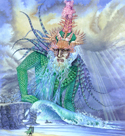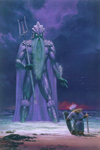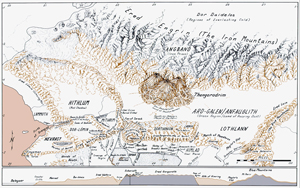SPECIAL GUEST:
The Scrolls of Middle-earth : IV. Determining Content of the Tuor Stories
Reading the Epic Tales in Original Form
IV. Determining Content of the Tuor Stories
A. Selecting a Version
Now that I decided the first scroll was to be a Gondolin story, I searched my collection of Tolkien books for material. The most pertinent books are the compendiums edited by Mr. Christopher Tolkien. I reviewed the Lost Tales, vols 1-5, as well as Appendix A of The Return of the King looking for material. The results were three stories that pertained to both Tuor's journey to Gondolin and the Fall of Gondolin. I settled on the two versions - Of Tuor and His Coming to Gondolin from Unfinished Tales and The Fall of Gondolin from The Book of Lost Tales Vol 2. The third story is a summary version entitled Of Tuor and the Fall of Gondolin from the Silmarillion.
I wanted an "as-it-happens" narrative rather than a simple explanation or summary of the ancient story. So I passed over the Silmarillion version as a main source. However, I did use some of the phrasings from the ending to round out the Fall of Gondolin scroll. The two other versions fit the narrative/dialog requirement. The Unfinished Tales story of Tuor's journey is detailed with lots of dialog so I started with that for the first scroll. The Book of Lost Tales story actually includes a version of Tuor's journey. After the first scroll was done I compared it to the beginning of the Book of Lost Tales version and used only the portions after Tuor's arrival to complete the second scroll.
The two tales overlap in the content of approximately one page of text. It is the arrival of Tuor through the final gate of the Hidden Way and viewing Tumladen for the first time. The overall effect is the two scrolls together complete the epic of Tuor and the final destruction of Gondolin.
B. Editing the Stories
The texts were scanned into the computer using Caere Omnipage Pro with an HP Scanjet. I made enlarged copies of the text to aid in scanning. The flat pages and larger text size made for fewer mistakes compared to the result from directly scanning the two source books. The pictures were scanned using Adobe Photoshop.
I edited the text of the stories. I am not a professional editor nor writer. But I wished to make the text more readable for the average 15 year old to adult age range. The main task was to break up the longer sentence-constructs composed of successive phrases separated by semicolons. Also, I occasionally broke longer paragraphs into multiple, shorter ones. The overall effect was to make the text easier to read. The short snappier sentences and the smaller paragraphs make the viewing of the text on the page easier. They provide extra white space or visual "resting" places for the eyes. Even the most hardened readers among us cringe when confronted with a long paragraph that takes up almost an entire column on a page. In addition, the Lucida Calligraphy script-style font requires extra effort to read compared to the less ornate Times New Roman or Courier fonts to which we are accustomed from books and newspapers.
Examples of the changes include
- Names & types
- I changed Bronweg to Voronwe in the Fall of Gondolin to match Tuor's guide's name from the journey story. I also changed the term 'Gnome' to 'Elf' throughout.
- Superlative Phrases
- One phrase stands out from the ending of the Tuor journey story when he gazed out over Tumladen for the first time. Listed below is the original and my edited version. The original sounds a bit 'over the top' to modern ears - even if I felt the same way when I first saw Mr. Nasmith's picture of the event.
- Original: "...for he saw before him at last the vision of his desire out of dreams of longing." 2
- Edited: "...for he saw before him at last the vision of his desire."
- Long, Semicolon Paragraphs
- Here is an example from the Fall of Gondolin at the part where the Houses of Gondolin are forming ranks to defend the city. The original single paragraph I broke into two and eliminated several semicolons. Not major changes, but enough to make the text flow a bit more easily to the modern ear.
- Original: (changes are in bold)
"Then came there from the south of the city the people of the Fountain, and Ecthelion was their lord, and silver and diamonds were their delight; and swords very long, bright and pale did they wield, and they went into battle to the music of flutes. Behind them came the host of the Harp, and this was a battalion of brave warriors; but their leader Salgant was a craven and he fawned upon Meglin. They were dight with tassels of silver and tassels of gold, and a harp of silver shone in their blazonry upon a field of black; but Salgant bore one of gold, and he alone rode into battle of all the sons of the Gondothlim, and he was heavy and squat." 3
- Edited:
"Then came there from the south of the city the people of the Fountain, and Ecthelion was their lord, and silver and diamonds were their delight. Swords very long, bright and pale did they wield, and they went into battle to the music of flutes.
Behind them came the host of the Harp. While this was a battalion of brave warriors, their leader Salgant was a craven and he fawned upon Meglin. They were dight with tassels of silver and gold. A harp of silver shone in their blazonry upon a field of black. Salgant bore one of gold, and he alone rode into battle of all the sons of the Gondothlim, and he was heavy and squat."
C. Inserting Illustrations
Once the text was finalized, I looked over my picture resources to determine which artwork to include and where to place each picture in the scroll. My personal preference tends toward the more photographic style Tolkien art. Maybe it derives from my extensive interest in the Renaissance period. During that period art took on a new realism with the advent of perspective and other factors. So I tend to favor the art of Messrs. Nasmith and Howe.
I did use some pictures for an illustration for which they were not originally intended. The main reason is a lack of artwork to portray a portion of the story. I use a full painting or a smaller portion if the artwork does not specifically identify a different scene. For example, there is a picture of the Uruk-Hai around a campfire from the kidnapping of Merry & Pippin in The Two Towers. The painting is by Mr. Howe. I can not discern any markings that would identify the orcs as belonging to either Saruman (the white hand) or Sauron (the lidless eye). So I used it to illustrate the part of Tuor and His Coming to Gondolin where Tuor and Voronwe must sneak around orc camps as they cross the North-South roadway between Tol Sirion and Nargothrond.
Another example of alternative use is the inclusion of the Battle of Fingon and Gothmog from the Battle of Unnumbered Tears where the Elf King met his end. The artwork is by Mr. Nasmith from the 2000 calendar. Its a great picture of Gothmog and I use it for the confrontation of Gothmog and Ecthelion at the fountain in the main square of Gondolin. Strictly speaking, one does not see a fountain or any other city structures in the background, but otherwise the picture gives the proper impression of Ecthelion's courage to challenge the Balrog.
|
There are also places where I use multiple illustrations of the same event by separate artists. A case in point is
the three pictures of Ulmo, Lord of Waters. The three pictures all pertain to Ulmo's visitation to Tuor at
Vinyamar. In the course of the text there is a place for all three pictures. First is the picture by Mr. Roger
Garland. Ulmo is a massive sea-god rising up out of the ocean. He is of titanic proportions and encrusted with
coral-like structures. This is a great instill-a-sense-of-awe entrance by the sea god.
|

Ulmo Visits Tuor
by Roger Garland
|

Ulmo Visits Tuor
by Ted Nasmith
|
Second, as the conversation takes place between Ulmo and Tuor I switch to Mr. Nasmith's picture. It shows
Ulmo with "only" gigantic proportions compared to Tuor. I felt it represented a reasonable scene wherein
Ulmo could converse without overwhelming Tuor. In addition I can better imagine the relative sizes of
Ulmo's cloak and a lappet he gives to Tuor. You can see a portion of this picture in the border
illustration earlier in this article.
|
|
Finally, the picture by Mr. Howe shows Ulmo of titanic proportions again in the midst of a brewing storm. Ulmo
wears a Viking style winged helmet and holds a trident. He is now moving away from Tuor back to the depths and
we see the danger Tuor faces from the wake of a perambulating god. He needs must retreat hurriedly lest he be
swept away by the storm.
|

Ulmo Visits Tuor
by John Howe
|
I have already updated a couple of pictures from the first version of the Tuor scrolls. I originally used a portrait of a Noldor Warrior from the book Tolkien, The Illustrated Encyclopedia for the scene where Tuor meets the two elves at the Noldor Gate. However, I replaced it with Mr. Nasmith's painting of Tuor and the elves descending the stairs of the Gate when the 2000 Tolkien calendar became available.

Lands to the North of Beleriand
by Karen Wynn Fonstad
|
A special mention must be made for Ms. Karen Wynn Fonstad. Her Atlas of Middle-earth is a great addition
to the appreciation of Tolkien's work. I use her maps and diagrams wherever possible. Maps in the Tuor scrolls
include Lands to the North of Beleriand 4 to show where Tuor grew up and the distances involved in his journey from
Vinyamar to Gondolin. Also included is the drawing of the Noldor Gate and of Gondolin proper to help the reader
visualize particular geographic features occurring in the story. The bird's eye view of Gondolin is helpful
during the battle descriptions to show where the action is occurring as the forces of Morgoth advance through
the city. The Atlas is a critical tool for any Tolkien aficionado. It adds (literally) three-dimensional
depth to the distances across Middle-earth as well as an understanding of the topographical features of the
landscape.
|
D. Determining Storylines for the Scroll Border
The final element is the selection of the "border" storylines. I have placed the border stories in the scroll Tuor and His Coming to Gondolin, but have not finalized them for the Fall of Gondolin. The main criteria for a border story is the opposite of the feature desired in the main text of the scroll. Instead of a narrative with dialog, a summary style story fits better in the border. Its purpose is to provide additional background material pertaining to the main story. In addition, the border will be more challenging to read, physically, because it is entirely horizontal and printed in an unusual script. Therefore, lots of narrative detail will be hard to track back and forth across horizontal linear-feet versus re-reading the main text, which is measured in vertical column inches.
The Silmarillion story summaries are ideal for the scroll borders. I searched the book for material on Tuor, his parents, and his heritage - the third line of the Edain known as The House of Hador. I found the tale about his father and uncle who at one time lived in Gondolin 5. The story was sufficiently long that the main task was to trim it back to be only about 40 lines of 80 characters each. The length expands by about 40% when I change the font to my Elvish version, Lothlorian. The Huor/Hurin border story is then about 55 lines. Some editing was required to make the story fully match the 58 pages of the main text. I finally inserted hard carriage-returns at the end of each line and then pasted them into separate textboxes at the top of each slide in Powerpoint 97.
The border story for Turgon took extra work. A search did not produce a self-contained story of how Turgon developed Gondolin. So I searched the index in The Silmarillion for every reference to Turgon. I wrote down any phrases that pertained to the building of Gondolin from across several stories and then edited them into a descriptive sequence. The resulting storyline tells of
- Turgon's disquiet and need to build a stronghold against the might of Morgoth;
- the visitation by Ulmo and Turgon's discovery of the Hidden Way and Tumladen;6
- the secretive construction of Gondolin;
- the placement of the special livery behind Turgon's throne in Vinyamar; and finally
- the clandestine emigration from Vinyamar to Gondolin.7
The border stories for The Fall of Gondolin are not done. At present they are only un-researched ideas. One border will expand upon Maeglin, Turgon's nephew, and the other about Tirion on Tuna, the city on the coast of the Blessed Realm after which Turgon patterned Gondolin. With regard to Maeglin, the elements for a border story are present. I recall reading about Turgon's sister leaving Gondolin, her finding and marrying a "dark elf", and then the subsequent return to Gondolin by (at least) the "dark elf" and Maeglin. I believe during the course of events in Gondolin Meglin's father was killed. I do not recall all the details, but the tale is Chapter 16 in The Silmarillion entitled Of Maeglin. I will condense the nine pages to the proper length to fit the scroll.
The Tirion on Tuna idea is less developed. I hope to find descriptions of Turgon and Tirion, of how he loved that city, and of his anguish upon leaving it. I do not recall reading such descriptions. This idea may be problematic to implement and if so, another one will be needed. At the present time I have no other candidate.
NEXT: Determining Content of the Beren & Luthien Tale
|
![[ Green Books ]](http://img-greenbooks.theonering.net/images/gb_logo.gif)
![[ Green Books - Exploring the Words and Worlds of J.R.R. Tolkien ]](http://img-greenbooks.theonering.net/images/gb_topnav.gif)




